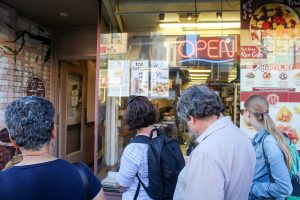Exploring the roots of Korea Town
By Annemarie Brissenden
A heritage tour of Toronto’s Korea Town starts — as it should — at the Bloor Street United Church of Canada, once home to the Alpha Korean United Church.
Founded in 1967 when there were just over 200 Koreans living in Toronto, it’s the oldest Korean congregation in the city, and the third oldest in Canada after Montreal and Vancouver.
The history of Korean immigration to Canada is inextricably linked to some of Canada’s early religious institutions and their missions. The first Canadian (that we know of) to visit Korea was a missionary from Toronto, James Scarth Gale. After arriving in 1888, he would become famous in Korea for creating the first Korean-English dictionary and the first Korean translation of the Bible.
Another missionary, Dr. Francis Schofield, sent by the Presbyterian Church of Canada to Korea in 1916, would become involved in the 1919 Independence Movement against Japan and later be the only foreigner buried in the patriots’ section of the Korea National Cemetery.
These are but two of the 184 Canadian missionaries who helped to modernize education and medicine in Korea between 1888 and 1941. But it wasn’t until a 1967 change in Canada’s immigration policy that Koreans started coming to Canada, settling mostly in Toronto, where the Alpha Korean congregation served as a haven of faith and togetherness.
These days, there are approximately 73,390 Canadians of Korean descent who call Toronto home. And while few actually live in Korea Town any more, the stretch of Bloor Street between Bathurst and Christie streets in Seaton Village is still an epicentre of Korean business, culture, and, of course, food.
“We have special places that are Korean [and] that focus on celebrating Korean culture, like my parents’ restaurant [Korean Village Restaurant],” says Jason Lee, who grew up in Korea Town and gives tours of the strip on behalf of Heritage Toronto.
The stops on his tour include KCWA Family and Social Services on Madison Avenue, the Palmerston Library, P.A.T. Central, and the Korean Senior Citizens Society of Toronto.
Each stop has its own significance.
Founded in 1985 by a group of women concerned with women and family issues, the KCWA is dedicated “to building the Korean-Canadian community, one person at a time”, according to its website.
“I didn’t know of the [KCWA],” said Camille Begin, a program coordinator with Heritage Toronto, who participated in Lee’s most recent walk during the summer. “That is the point of this walk; even if you live in the neighbourhood there is still a lot you don’t know and you could learn a lot.”
The Korean Village Restaurant and P.A.T. Central are key stops on the tour because they are emblematic of key aspects of Korean-Canadian culture: entrepreneurship and food.
The Korean Village Restaurant is a traditional Korean family business, while P.A.T. — which calls itself Canada’s first Korean supermarket — supplies everything you need to host a traditional Korean meal, including, of course, kimchi.
The Palmerston Library — once affiliated with the YMCA — was where immigrants took classes to learn how to speak English and got help adjusting to their new city. Still a part of the local Korean-Canadian experience, the branch has over two thousand Korean language pieces in its collection.
Finally, the Korean Senior Citizens Society of Toronto is a drop-in centre that provides counselling, recreational programs, and classes from its location at the corner of Grace and Bloor streets.
This year’s tour came at a time when some people are wondering whether Korea Town is on a decline, with businesses starting to change hands to newer immigrant groups and many Koreans moving north. (Even the Alpha Korean United Church has relocated to a new site near Sheppard Avenue and Yonge Street.)
But Lee remains undaunted.
“As long as those places are still there, we are promoting Korean culture; in my view Korean culture is still alive. People say that it is dying but the way I look at it Korea Town is changing just like any other neighbourhood. We adapt, we survive.”
He wants to keep hosting the walks — glimpses into the immigrant experience — for as long as he can.
“It is a privilege. I do this as a way of honouring the past,” Lee said.
—with files from Temi Dada

